Muslin is a plain cotton fabric with a light, smooth, and supple feel. For centuries, artisans in India, Bangladesh, and the Middle East carefully wove it by hand, making it a highly valued textile. Today, manufacturers around the world produce muslin in a range of grades and finishes, catering to various applications, from clothing to home textiles.Muslin originated in Dhaka, now part of Bangladesh, where it gained fame for its pure, almost translucent appearance. During the 17th and 18th centuries, the fabric became a symbol of luxury in Europe, adored for its delicate elegance. Known as “mulmul” in South Asia, traders transported it along the Silk Road, and royalty treasured it for its fine, ethereal quality.
Table of contents
What is Muslin Fabric?
Muslin fabric, a soft and delicate cotton textile, has long earned a reputation for its versatility and elegance. Artisans in ancient India originally crafted this fabric, valued for its softness, flexibility, and wide range of applications. Today, industries across the world appreciate muslin for its intricate craftsmanship and practical uses, making it a revered choice in the textile world.
The Properties of Muslin Fabric
People recognize muslin fabric for its unique combination of attributes that make it incredibly flexible and suitable for use across a variety of industries. Let’s take a closer look at the qualities that differentiate muslin from other fabrics.
1. Lightweight and Airy
Muslin is renowned for being incredibly breathable and lightweight. This loose cotton yarn wicks air easily, which makes it a perfect fabric for warm weather and climates where ventilation is important. This thin quality also gives muslin its voluminous feel.
2. Soft and Comfortable
Perhaps muslin’s most attractive feature is softness. The delicate cotton fibres it is made from create a silky soft feel that glides over the skin. This makes it an ideal fabric for swaddle blankets and burp cloths for babies, as well as for summer wear.
3. Highly Absorbent
Muslin absorbs naturally, which is why it’s widely used in kitchen cloths, cleaning cloths and infant clothes. It can quickly absorb liquids and moisture, making it suitable for use in culinary processes, like straining sauces or chopping cheese.
4. Quick-Drying
Because of its light texture and cotton content, muslin fabric dries quickly after use. Its feature makes it ideal for use on reusable kitchen towels or baby wraps that need to be regularly washed.
5. Durable and Long-Lasting
Muslin, as soft as it looks, is not particularly brittle. High-quality muslin doesn’t unravel when washed and worn many times. But, it may or may not have a higher or lower durability depending on the weave grade and thickness.
6. Versatile in Texture and Finish
Muslin comes in a wide range of textures and finishes, from light, fuzzy weaves to heavier, stronger forms. This adaptability makes it applicable for anything from delicate fashion pieces and drapes to utilitarian household products.
7. Easy to Dye and Embroider
Muslin absorbs dye exceptionally well, absorbing color intensely and evenly. It also makes for a perfect background for embroidery and other ornaments, so it’s a popular option for designers and artists.
8. Hypoallergenic and Skin-Friendly
Muslin is composed of natural cotton fibers that are hypoallergenic and skin-friendly. This feature makes it a safe and comfortable choice for skin-sensitive individuals, as well as babies and children.
9. Eco-Friendly and Sustainable
Because muslin is typically 100 per cent cotton, it is biodegradable and non-toxic. It can be recycled, composted, or refashioned, which makes it an ideal option for those who want sustainable textiles.
10. Breathable Yet Protective
Although breathable, muslin acts as a barrier to dust, insects and even light. This equilibrium has made it a favorite material for clothing bags, dust masks, and lightweight curtains.

How Muslin Fabric is Manufactured:
Muslin cloth production has changed over centuries, moving from traditional handweaving to modern machine-generated production. However, even this innovation is grounded in the traditional technique of employing fine cotton fibres that lend muslin its characteristic drape and breathable qualities. The manufacturing process for muslin fabric is listed below, one step at a time.
1. Sourcing the Raw Cotton
Muslin production starts by finding high-quality cotton threads. They are typically extracted from cotton crops in warm countries like India, Bangladesh, Egypt and the United States.
Choice of Cotton: The superiority of muslin relies heavily on the choice of cotton. Long-staple cotton, such as Egyptian or Pima cotton, provides a lighter and smoother feel.
Ecologically Responsible: Today, manufacturers tend to source organic or sustainably cultivated cotton in an effort to mitigate environmental impacts.
2. Cleaning and Carding the Cotton
Cotton harvesters clean the cotton to remove impurities, such as seeds, dirt, and plant material. The carding process then aligns and separates the fibers mechanically, forming a soft cotton web. This procedure ensures the fibers distribute evenly, preparing them for spinning into yarn.
3. Spinning the Yarn
Artisans spin carded cotton fibers into yarn using old-fashioned spinning wheels or industrial spinning machines. In traditional practices, especially in rural areas, they often hand-spin cotton to create soft, delicate yarns for luxurious muslin. In large-scale production, manufacturers use industrial spinning machines to produce high-quality yarn with greater consistency.
4. Weaving the Fabric
After spinning the yarn, manufacturers simply weave the material into cloth.
Basic Weave Pattern: Weavers use a basic over-under stitch to create muslin, where the weft (horizontal) yarn loops over and under the warp (vertical) yarn. This simple pattern produces a thin, airy, smooth fabric.
Handloom vs. Power Loom:
Handloom Weaving: In countries such as India and Bangladesh, craftspeople continue to use handlooms to weave muslin cloth, which people highly prize for its quality.
Power Loom Weaving: Automated power looms used in contemporary factories produce muslin more regularly and efficiently on a mass scale.
5. Washing and Bleaching
After completing the weaving process, manufacturers wash the fabric to remove any oils, dirt, or starch that remains.
Depending on the application, they may also bleach muslin to achieve a more translucent, uniform shade.
Natural Muslin: A few muslin fabrics remain raw, unbleached, and have a pale off-white or cream color.
Bleached Muslin: For those uses that need the fabric to be white and pure, the fabric is bleached with natural bleach.
6. Quality Control and Inspection
Prior to distribution, the fabric is thoroughly tested for defects, including:
Uneven weaving
Loose threads
Inconsistent dyeing or bleaching
Excellent muslin should have a smooth, even surface and no imperfections.
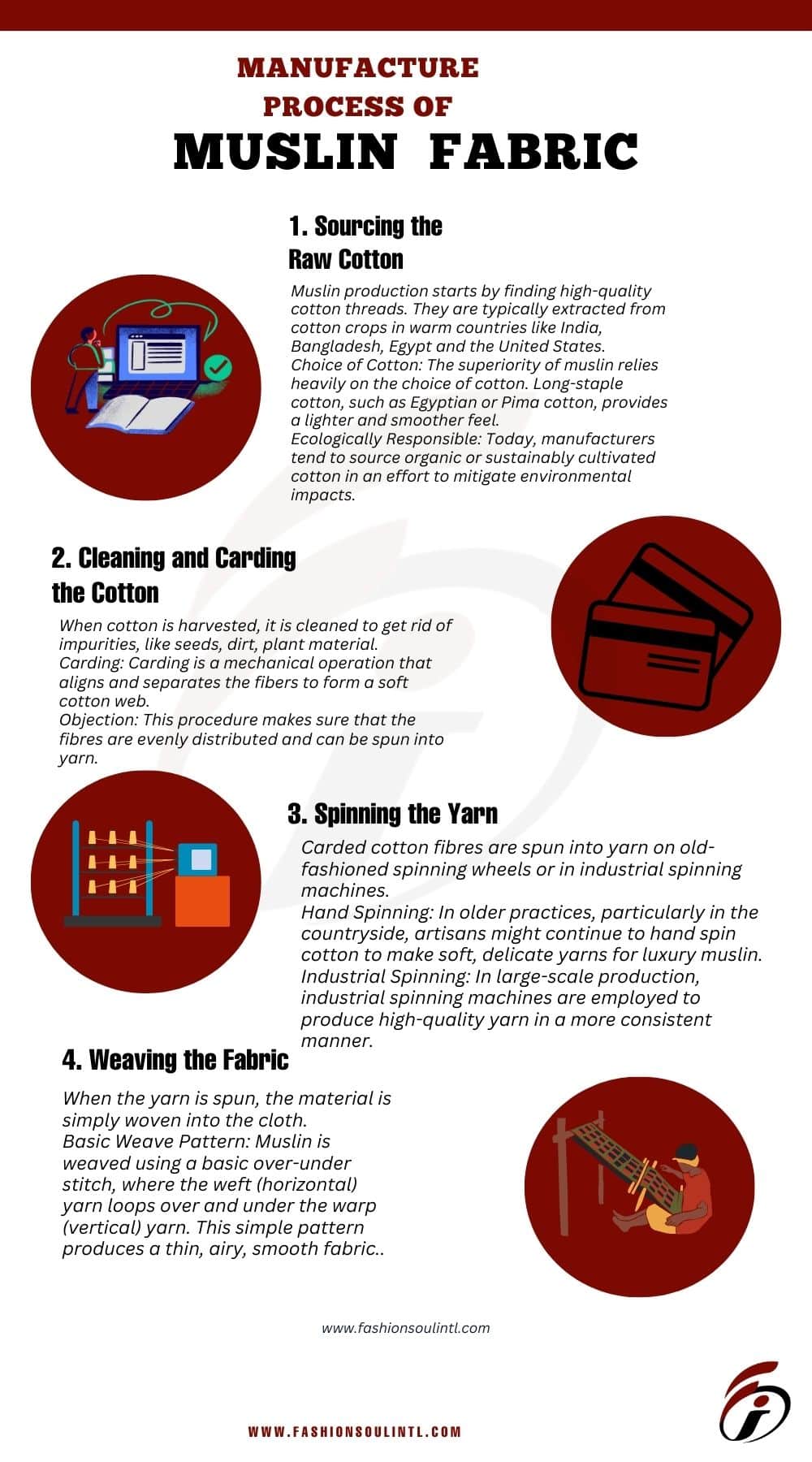
Common Uses of Muslin Fabric:
Muslin fabric finds applications in many industries for its versatility. Here are some of its most commonly used uses:
1. Fashion and Apparel
Garment Prototyping: Designers work with muslin to prototype or mock-up garments before rippling expensive fabrics.
Summer Dresses: This fabric is breathable, and therefore great for summer dresses, skirts, and blouses.
Wearing petticoats and chemises: In the past, muslin was used for petticoats and chemises.
2. Baby Products
Swaddle Blankets: The breathable fabric won’t scratch a baby’s sensitive skin.
Burp Cloths: Muslin absorbs very well, making it a perfect burp cloth material.
3. Home Décor
Curtains: The sheer, translucent fabric of muslin allows natural light to shine through and create a warm space.
Cloths and napkins: Muslin is often used as an informal tablecloth, because it’s simple to clean.
4. Culinary Applications
Cheesecloth Replacement: You can use muslin to strain out liquids like cheese or nut milk.
Steaming & Baking: It can also be used to bundle herbs or spices for broths.
5. Medical and Industrial Uses
Bandages: In some instances, a thin and breathable bandage is made from muslin.
Theatre and Photography Backgrounds: Because of its neutral color and texture, it is a favorite for background designs.

Types of Muslin Fabric:
There are several kinds of muslin fabric and each type has its own properties and uses. These variations in texture, weight, weave and finish have made muslin an adaptable fabric for fashion, upholstery, baby clothing and industrial applications. Here we take a look at the primary varieties of muslin fabric, and their distinct properties.
1. Gauze Muslin
Gauze muslin is an ultra-thin, open-faced fabric that is breathable. It’s often a little translucent and a little crinkly.
Characteristics:
Extremely lightweight and breathable.
Soft, delicate texture.
Open weave for good airflow.
Common Uses:
Swaddle blankets for babies.
Summer clothes: Lightweight blouses and dresses.
Food use: Cheesecloth or squeezing cloth.
Bandages and medical gauze.
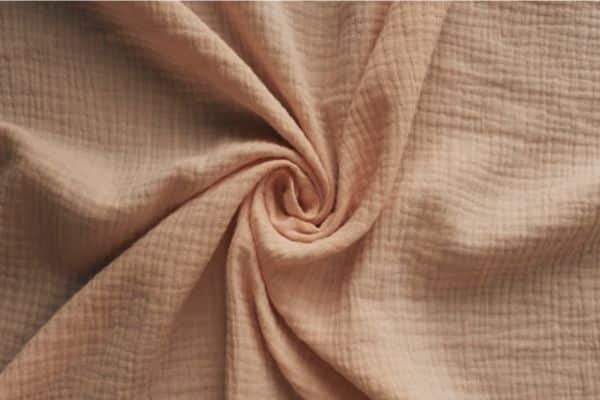
2. Mull Muslin
Mull muslin is a delicate, lightweight, and slightly stiffer fabric than gauze muslin. It is frequently employed as a background fabric for garments or for interfacing.
Characteristics:
Soft, yet much pricier than gauze muslin.
Just a little bit translucent and silky.
Soft, yet retains some structure.
Common Uses:
Jackets for clothing, particularly suits or night dresses.
Fabric for garment prototype (toiles).
Curtains and drapes for a clean, elegant feel.
Bookbinding and decorative crafts.

3. Swiss Muslin
Swiss muslin is an ultra-thin, fine, wrinkle-free fabric. Small dotted designs or embroidered elements often adorn it.
Characteristics:
Ultra-thin and tight weave, soft to the touch.
Sometimes embroidered or polka-dotted.
It is thinner than gauze muslin, but lighter.
Common Uses:
Babies’ dresses, christening dresses, and child’s wear.
High-end summer dresses and blouses.
Pleated curtains and ornamental household furniture.
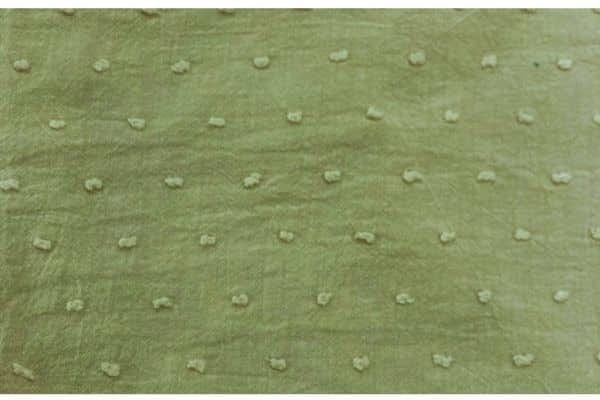
4. Sheeting Muslin
Sheeting muslin is a more durable, dense fabric than other muslins. It is simply woven and is frequently employed for everyday uses that require long-term durability.
Characteristics:
It’s heavier and has a stiffer weave.
Durable and long-lasting.
Smooth and slightly stiff texture.
Common Uses:
Bed sheets and pillowcases.
Linen or furniture covers for upholstery.
Images for photographs and stage costumes.
Industries use, for example, filters and dust covers.

5. Voile Muslin
Voile muslin is a sheer, lightweight fabric with a satiny finish. We usually confuse it with voile, though the muslin version has a slightly different weave and texture.
Characteristics:
Semi-transparent, fine-woven fabric.
Lightweight and breathable.
It drapes softly, as you’d expect.
Common Uses:
Summer dresses, skirts, and tunics.
Sheer curtains and decorative drapes.
Scarves, shawls, and lightweight accessories.
Wedlocks and other straitjackets.

6. Unbleached Muslin
Raw muslin keeps its natural colour and grain, making it look raw and natural. It is commonly employed for practical reasons or where a more natural look is desired.
Characteristics:
Natural, off-white or beige color.
Breathable and comfortable, but somewhat rough in texture.
No chemical treatments or dyes.
Common Uses:
Garment prototypes or mock-ups.
Sustainable produce bags and reusable packages.
Upholstery lining and dust covers.
DIYs and natural decor
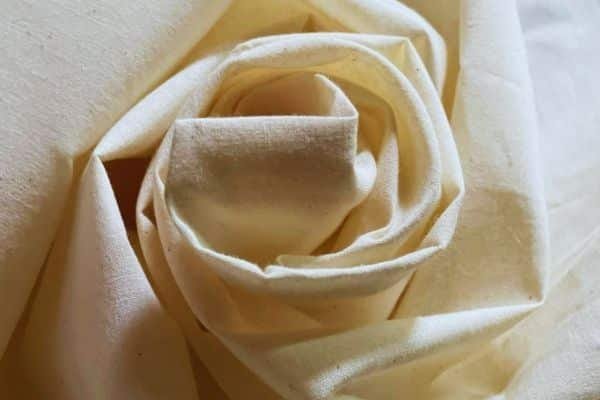
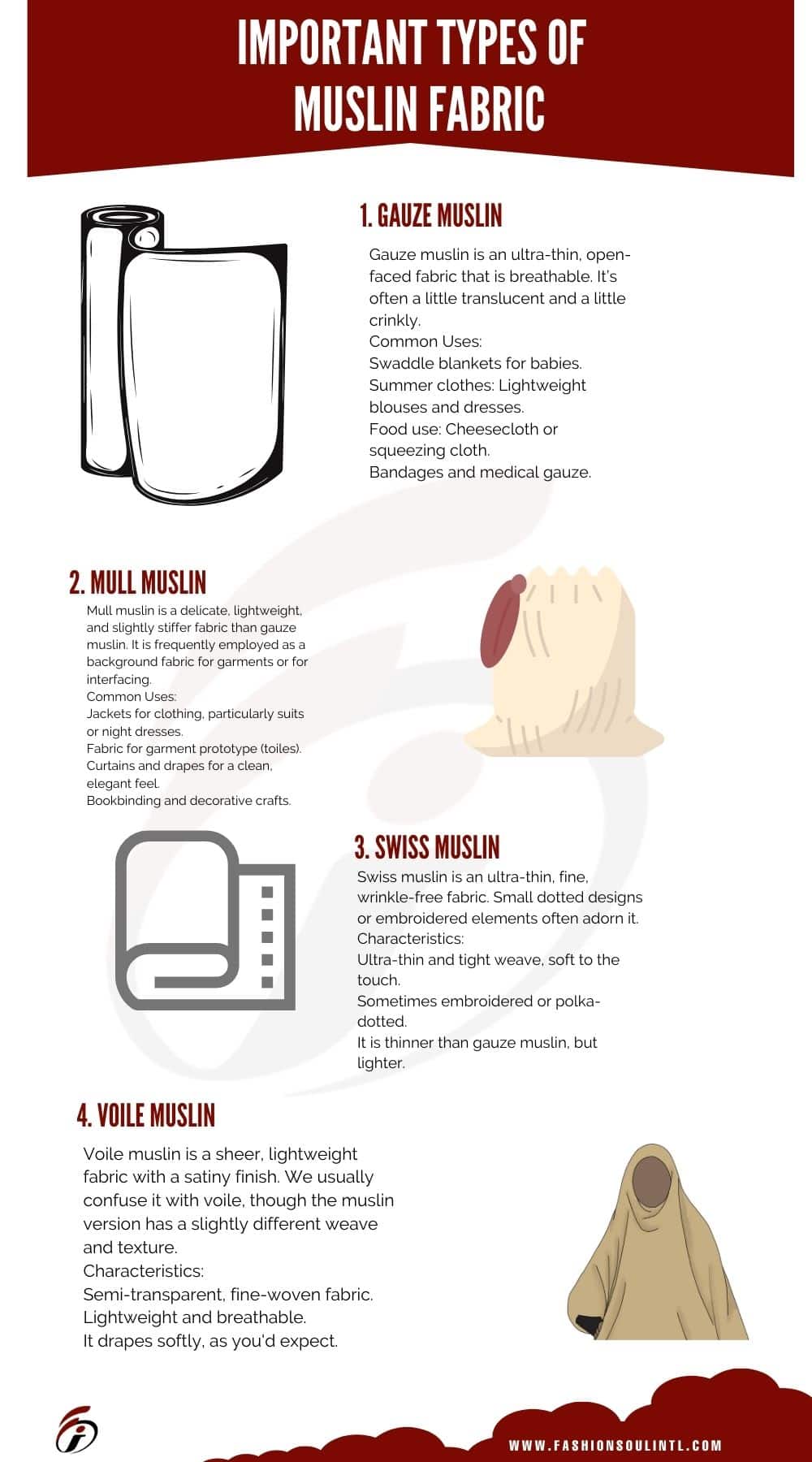
Caring for Muslin Fabric:
Muslin is comparatively simple to maintain, and a few simple guidelines can help keep it looking its best:
Care: Muslin can be machine washed on a gentle cycle with mild detergent.
Drying: You should dry your clothes with the dryer on high to avoid shrinkage, however, if it’s necessary you can tumble dry on low.
Ironing: Turn on low to medium heat and iron while the fabric is slightly wet so that it does not dry out.
Storage: Keep muslin dry and out of direct sunlight as much as possible to prevent it from yellowing.
Why Choose Muslin Fabric?
Muslin fabric combines comfort, versatility, and design. Whether you’re searching for a lightweight summer dress, an effective household fabric or a unique photography prop, muslin is a cost-effective, sustainable alternative. Plus, due to its natural cotton content, it’s also eco-friendly for those who want a natural alternative to artificial fabrics.
What is Brocade Fabric?
Brocade has stood for class and beauty for centuries. Kings, priests and haute couture fashion designers preferred this fabric for its intricate design. Brocade displays more than a decoration; it is a demonstration of exceptional craftsmanship. Here, in this article, we will explore what brocade cloth is, what it is used for, and how it is made, as well as why it is still among the most used fabrics in the world today.
Conclusion:
Muslin is a timeless material that combines function with elegance. It’s comfortable, breathable and versatile across industries, making it a wardrobe staple for homes and offices. Whether you’re new to textiles, or simply wanting to get a little more informed, muslin is both an interesting combination of history, art and function.
FAQs
Muslin is traditionally woven from cotton, although it can be sewed onto natural fibres such as silk or bamboo.
Yep, muslin is highly breathable, perfect for the summer. You can also layer it during the cooler months.
Muslin generally goes for less than $100, but will be more or less depending on the quality and type of cotton you are using.


